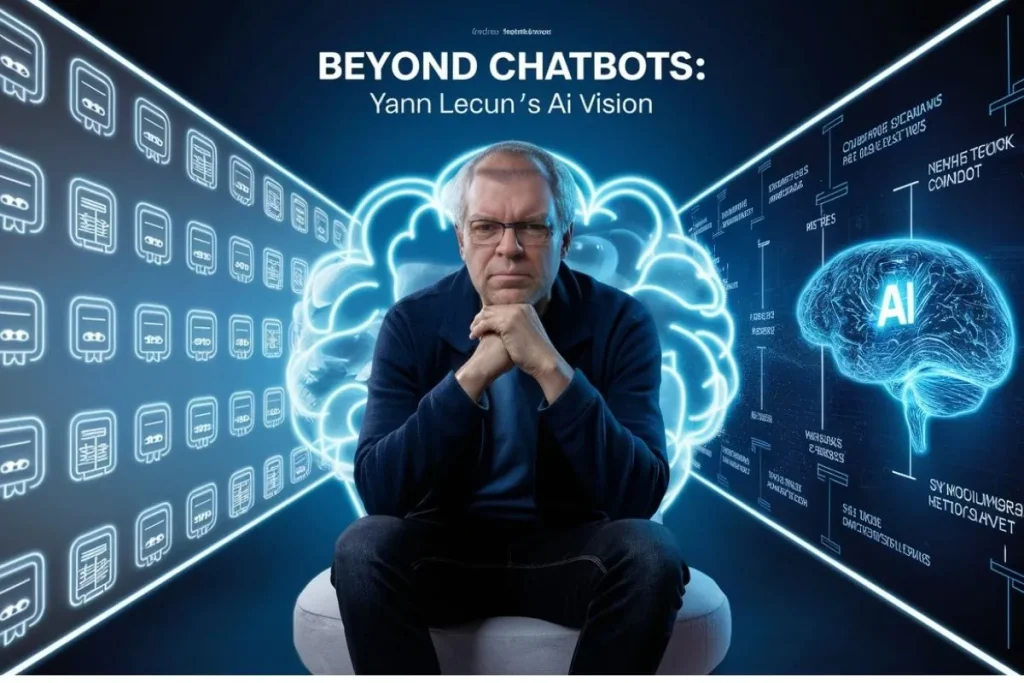Open-Source AI: Artificial Intelligence (AI) is rapidly transforming the world, but where does its future truly lie? Yann LeCun, Meta’s Chief AI Scientist and a pioneer in deep learning, offers groundbreaking insights into open-source AI, the limitations of chatbots, and the promise of technologies like V-JEA that hold the key to building more intelligent machines.
- Open AI Launching Search Engine: Google VS Chat GPT The Ultimate AI WAR?
- The Rise of AI Content: What It Means for Creators and Consumers!
Yann LeCun’s Blueprint for True Artificial Intelligence
Yann LeCun is a firm advocate of the open-source AI philosophy. He believes that a collaborative and open environment, akin to the rise of open-source software, is crucial to accelerate innovation in the AI field.
LeCun acknowledges the impressive strides made by Large Language Models (LLMs) like ChatGPT but believes they represent a stepping stone. True intelligence, he argues, requires going beyond language patterns to include:
- Understanding of the World: AI systems need to develop a model of the physical world and its rules.
- Persistent Memory: Integrating knowledge over time, like humans do.
- Reasoning Abilities: Capacity for new logical thinking beyond trained data.
- Planning Power: Formulating plans and adapting to unforeseen situations.

LLMs vs. the Future of AI: A LeCun Perspective
| Feature | Large Language Models (LLMs) | Advanced Machine Intelligence (AMI) |
| Understanding | Limited to language patterns | Models the physical world |
| Memory | Context-dependent | Persistent, like human memory |
| Reasoning | Can mimic logic within data | Capable of new logical deduction |
| Planning | Struggles in novel situations | Adapts and forms plans to achieve goals |
V-JEA: Teaching AI to ‘See’ & Understand
LeCun champions V-JEA (Joint Embedding Architectures) as a critical step towards achieving more intelligent AI. This approach focuses on training AI models on videos and asking them to predict future frames. Think of it like a child learning how the world works by observing how objects interact – dropping a ball makes it fall, stacking blocks might make them topple. By doing so, these systems build a representation of the physical world.
Beyond LLMs – The Promise of ‘AMI’
This ‘world model’ forms the basis for future AMI (Advanced Machine Intelligence) systems. AMI-powered machines could potentially revolutionize how AI tackles problems by allowing them to plan and predict outcomes of actions.
AI’s Potential: Not Just Scientists, But Everyday Tasks
LeCun acknowledges it may be a while before AI rivals top physicists. However, even AI with the common sense of a household pet or the ability to master tasks humans take for granted, like clearing a table or driving, could transform countless industries and aspects of life.
The Power of Open-Source AI
A collaborative, open-source approach is crucial to achieving this potential. By sharing models and knowledge, the AI community accelerates the pace of innovation, pushing the boundaries of what’s possible.
Conclusions: Yann LeCun’s insights offer a realistic yet inspiring look at where AI is headed. True, intelligent AI requires us to think beyond mere language prowess. By teaching AI to ‘see’ and understand the world like V-JEA proposes, we draw closer to systems that can reason, plan, and solve problems in ways that will fundamentally redefine our relationship with technology.




















